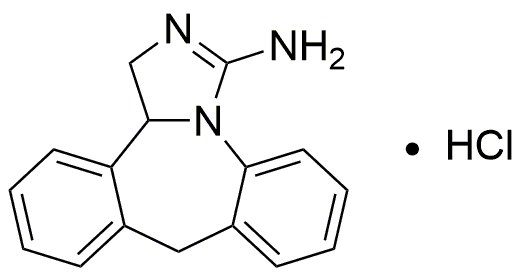Epinastine hydrochloride is widely utilized in research focused on:
- Allergy Treatment: This compound is primarily used in the formulation of antihistamines, providing relief from allergic symptoms such as sneezing, itching, and runny nose.
- Ophthalmic Solutions: It is commonly found in eye drops for treating allergic conjunctivitis, helping to alleviate eye irritation and redness effectively.
- Clinical Research: Epinastine hydrochloride is a subject of various studies aimed at understanding its efficacy and safety in treating allergic reactions, contributing to advancements in allergy management.
- Pharmaceutical Development: The compound serves as a model for developing new antihistamines, allowing researchers to explore modifications that enhance therapeutic effects or reduce side effects.
- Comparative Studies: It is often used in comparative studies with other antihistamines, helping to identify its advantages, such as a lower sedation effect, making it suitable for daytime use.
Información general
Propiedades
Seguridad y normativas
Aplicaciones
Epinastine hydrochloride is widely utilized in research focused on:
- Allergy Treatment: This compound is primarily used in the formulation of antihistamines, providing relief from allergic symptoms such as sneezing, itching, and runny nose.
- Ophthalmic Solutions: It is commonly found in eye drops for treating allergic conjunctivitis, helping to alleviate eye irritation and redness effectively.
- Clinical Research: Epinastine hydrochloride is a subject of various studies aimed at understanding its efficacy and safety in treating allergic reactions, contributing to advancements in allergy management.
- Pharmaceutical Development: The compound serves as a model for developing new antihistamines, allowing researchers to explore modifications that enhance therapeutic effects or reduce side effects.
- Comparative Studies: It is often used in comparative studies with other antihistamines, helping to identify its advantages, such as a lower sedation effect, making it suitable for daytime use.
Documentos
Hojas de datos de seguridad (HDS)
La SDS proporciona información de seguridad completa sobre la manipulación, el almacenamiento y la eliminación del producto.
Especificación del producto (PS)
La PS proporciona un desglose completo de las propiedades del producto, incluida la composición química, el estado físico, la pureza y los requisitos de almacenamiento. También detalla los rangos de calidad aceptables y las aplicaciones previstas del producto.
Certificados de análisis (COA)
Busque certificados de análisis (COA) ingresando el número de lote del producto. Los números de lote y de partida se pueden encontrar en la etiqueta de un producto después de las palabras "Lote" o "Lote".
Número de catálogo
Número de lote/lote
Certificados de origen (COO)
Este certificado de origen confirma el país en el que se fabricó el producto y también detalla los materiales y componentes utilizados en él y si se deriva de fuentes naturales, sintéticas u otras fuentes específicas. Este certificado puede ser necesario para cumplir con las normativas aduaneras, comerciales y regulatorias.
Número de catálogo
Número de lote/lote
Hojas de datos de seguridad (HDS)
La SDS proporciona información de seguridad completa sobre la manipulación, el almacenamiento y la eliminación del producto.
DownloadEspecificación del producto (PS)
La PS proporciona un desglose completo de las propiedades del producto, incluida la composición química, el estado físico, la pureza y los requisitos de almacenamiento. También detalla los rangos de calidad aceptables y las aplicaciones previstas del producto.
DownloadCertificados de análisis (COA)
Busque certificados de análisis (COA) ingresando el número de lote del producto. Los números de lote y de partida se pueden encontrar en la etiqueta de un producto después de las palabras "Lote" o "Lote".
Número de catálogo
Número de lote/lote
Certificados de origen (COO)
Este certificado de origen confirma el país en el que se fabricó el producto y también detalla los materiales y componentes utilizados en él y si se deriva de fuentes naturales, sintéticas u otras fuentes específicas. Este certificado puede ser necesario para cumplir con las normativas aduaneras, comerciales y regulatorias.


